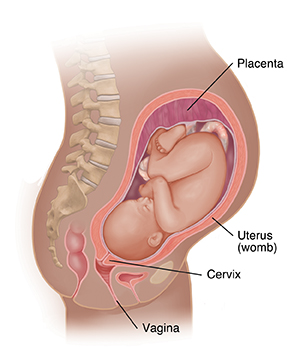Understanding Placenta Previa
The placenta is an organ that grows in the womb (uterus) in pregnancy. It sends the baby nutrients and oxygen in the womb. It removes waste from the baby’s blood. In some cases, the placenta grows too close to or over the opening at the bottom of the womb (the cervix) that leads to the vagina. This may happen in the second or third trimester. This is called placenta previa. The placenta may block part or all of the cervix. This can cause blood loss. It can also cause preterm labor.
 |
| Placenta in normal position. |
There are 3 types of placenta previa:
-
Complete. The placenta fully covers the cervix.
-
Partial. The placenta is partly over the cervix.
-
Marginal. The placenta is near the edge of the cervix.
Who’s at risk for placenta previa?
You are more likely to have placenta previa if you have any of these:
-
A multiple pregnancy (carrying more than 1 baby)
-
A past pregnancy and birth
-
Fibroids removed through an incision in the uterus (myomectomy)
-
A cesarean section scar low and close to the cervix
-
A history of smoking cigarettes
Diagnosing placenta previa
Placenta previa can cause bleeding in the second or third trimester. This doesn't cause pain. If this happens, an ultrasound can confirm the problem. But it may not cause bleeding. Your healthcare provider will look at the position of the placenta at routine ultrasound exams.
Treating placenta previa
The type of treatment you need depends on:
Treatments may include any of these:
-
Part-time or full-time bed rest
-
Blood transfusions to replace blood lost from the mother
-
Medicines to help mature the baby’s lungs
-
Medicines to prevent preterm labor
-
Cesarean section (this may be done right away if bleeding can't be stopped)
During treatment
Even if you aren't on bed rest, you may be told to restrict your activity. You will likely need to:
-
Not have sex
-
Limit travel
-
Not have pelvic exams
Getting support
It can be stressful and scary to be diagnosed with a problem in pregnancy. It may help to join a support group for people who are going through the same problem. Ask your provider to help you find a support group in your area. Or look for a support group online.
Online Medical Reviewer:
Donna Freeborn PhD CNM FNP
Online Medical Reviewer:
Heather M Trevino BSN RNC
Online Medical Reviewer:
Irina Burd MD PhD
Date Last Reviewed:
10/1/2022
© 2000-2025 The StayWell Company, LLC. All rights reserved. This information is not intended as a substitute for professional medical care. Always follow your healthcare professional's instructions.